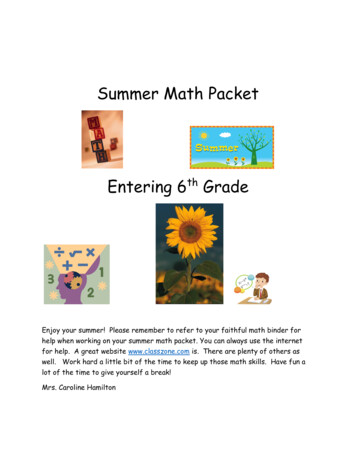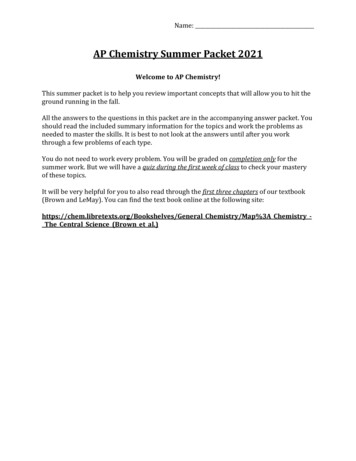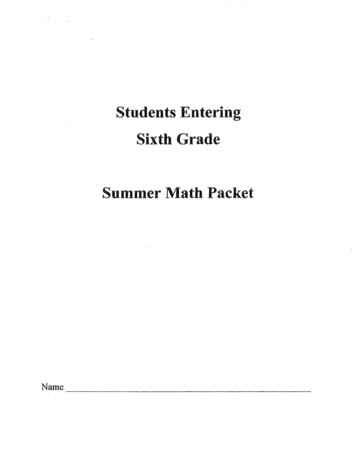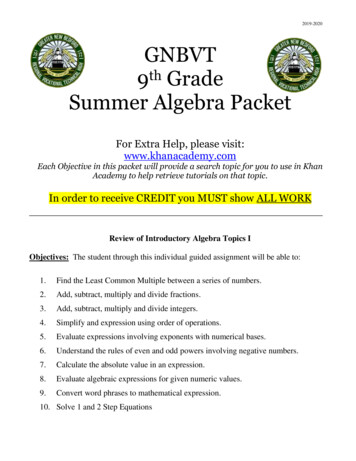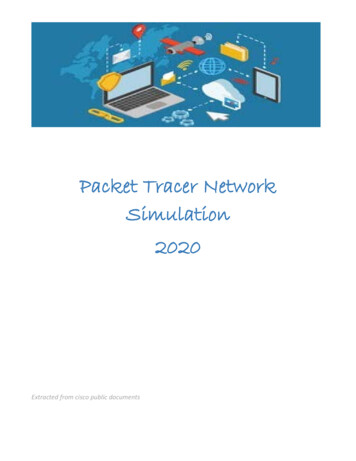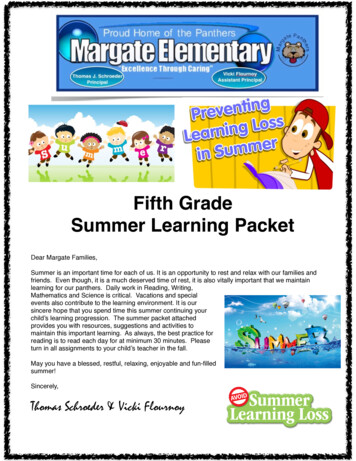
Transcription
Fifth GradeSummer Learning PacketDear Margate Families,Summer is an important time for each of us. It is an opportunity to rest and relax with our families andfriends. Even though, it is a much deserved time of rest, it is also vitally important that we maintainlearning for our panthers. Daily work in Reading, Writing,Mathematics and Science is critical. Vacations and specialevents also contribute to the learning environment. It is oursincere hope that you spend time this summer continuing yourchild’s learning progression. The summer packet attachedprovides you with resources, suggestions and activities tomaintain this important learning. As always, the best practice forreading is to read each day for at minimum 30 minutes. Pleaseturn in all assignments to your child’s teacher in the fall.May you have a blessed, restful, relaxing, enjoyable and fun-filledsummer!Sincerely,Thomas Schroeder & Vicki Flournoy
Take the Summer Literacy Adventure pledge rLitAdventure.aspxJUST READ, FLORIDA!2016 SUMMER LITERACY ADVENTUREFlorida’s First Lady Ann Scott and the Florida Department of Education have partnered with the Florida Lottery and theFlorida Department of Environmental Protection to announce the 2016 Summer Literacy Adventure.Literacy experts and educators agree that children of all ages need to be read to, read by themselves and talk about thebooks they have read during the summer. Your student’s summer reading and book discussions will help maintainreading skills, improve reading fluency and provide the opportunity to learn new vocabulary and concepts. Mostimportantly, when parents and children enjoy summer reading together, children develop a love of books and reading thatlasts a lifetime. According to research by Richard Allington (2007), by the time a struggling reader reaches middle school,summer reading loss has accumulated to a two-year lag in reading achievement. Researchers also conclude that two-thirdsof the ninth-grade reading achievement gap can be explained by summer learning loss. Let’s work together to helpstudents in Florida stay on track and not lose valuable ground in reading.The 2016 Summer Literacy Adventure is geared to help children stay on target, motivated and excited about reading andliteracy. During summer vacation, it is important for students of all ages and reading levels to spend time reading andwriting on a regular basis.To make reading even more exciting, we are challenging all of our state’s students to pledge to read as many books aspossible throughout the summer break, and I hope that you will encourage all of the teachers, students and parents in yourschool to participate. Each student can fill out his or her pledge on the Just Read, Florida! website at Summer LiteracyPledge. Following the summer break, the department will recognize the top 10 schools with the highest percentage ofparticipation. The school whose students read the most books will receive a surprise visit from First Lady Ann Scott.In addition to this challenge, here are some suggestions and resources for you, as the district literacy leader, to share withadministrators, reading coaches and teachers in every school in your community to encourage reading. Thank you foryour continued efforts to provide Florida’s students the resources and support they need to be successful in school and inlife.2016 SUMMER LITERACY ADVENTURE SUGGESTIONS AND RESOURCES: Provide tips to parents for summer reading. (See Parent Tips for Summer Reading attachment) Use up any remaining Parent–Teacher Organizational funds at the school or district levels by providing summer bookpacks. Book-packs include age-appropriate books at the student’s reading level with follow-up activities for students tocomplete during the summer break. Materials that support the themes of STEM (science, technology, engineering and mathematics); Materials that foster parental involvement, reinforce learning at home and support Florida Standards; and Resources that include, when possible, online engagement. Consider having “Open Library Nights” at your schools where children and parents can come and check out books andread at the school library. Media specialists may want to track grade-level participation and recognize thesechildren/grades at a schoolwide 2016 Summer Literacy Adventure Celebration. Consider allowing children to use classroom library books or media center books as tools to meet the Summer LiteracyAdventure challenge. Books can be checked out during summer library hours.
State Board of EducationPam StewartCommissioner of EducationMarva Johnson, ChairJohn R. Padget, Vice ChairMembersGary ChartrandTom GradyRebecca Fishman LipseyMichael OlenickAndy TuckMEMORANDUMTO:School District SuperintendentsFROM:Hershel LyonsDATE:May 13, 2016SUBJECT:2016 Summer Literacy AdventureContact InformationHope Colle850-245-0503Hope.Colle@fldoe.orgDPS: 2016-48Florida’s First Lady Ann Scott and the Florida Department of Education have partnered with theFlorida Lottery and the Florida Department of Environmental Protection to announce the 2016Summer Literacy Adventure. As summer is fast approaching, we encourage schools, studentsand parents to prepare for the summer break by participating in this fun challenge designed tohelp our state’s students maintain and improve their reading skills throughout the summermonths. Reading is a critical component of the learning process, and it is important that studentsand their families make reading a part of their daily routines even when school is not in session.To make reading even more exciting, we are challenging all of our state’s students to pledge toread as many books as possible throughout the summer break, and I hope that you will encourageall of the teachers, students and parents in your schools to participate. Each student can fill outhis or her pledge on the Just Read, Florida! website at Summer Literacy Pledge. Following thesummer break, the department will recognize the top 10 schools with the highest percentage ofparticipation. The school whose students read the most books will receive a surprise visit fromFirst Lady Ann Scott.Attached you will find additional information and resources to share with your school leadersand parents. Thank you for your support of literacy and the children of Florida.HL/hcAttachmentcc: K-12 District Reading ContactsHERSHEL LYONSCHANCELLOR OF PUBLIC SCHOOLSwww.fldoe.org325 W. Gaines Street!‐ Suite 1502 Tallahassee, FL 32399‐0400 850‐245‐0509
DEAR FAMILY,As many of you are planning for your summer activities for your children, we want you toremember to encourage your children to read over the summer break! Reading for the sake of readingwill allow children to explore summer from home, on the road, on vacation or from their own backyard!Many children forget what they’ve learned during the school year while on summer break. This“achievement loss” is also known as the summer slide. Keeping your kids’ engaged with reading overthe summer months will help maintain their academic edge and reduce the summer slide. Children whodo not read over the summer could potentially lose more than 2 months of reading achievement andunfortunately summer reading loss is cumulative.Good News: Margate Elementary encourages reading over the summer by providing your childaccess to myON, an online personalized collection of more than 5,000 digital books that can be read oncomputers, laptops, and other devices anytime, anyplace. We hope you enjoy the 2016 SummerReading Program!Your children can now read with myON over the summer & choose the books that they areinterested in.www.myON.comSchool: Margate Elementary SchoolUsername: Student NumberPassword: Birthday mm/dd/yyyyHAPPY READING!Sincerely,Patti MooreLiteracy Coach
Dear Parents and Guardians,We are very excited to announce that our math program called Reflex willcontinue to be available for the summer. It is important to continue to work onmath during the summer months. Reflex is a game-based system that helps studentswith math fact fluency. Over the course of a student’s first few sessions, Reflexlearns which facts and fact families the student is not yet fluent with and it uses thisinformation when making instructional decisions for that student. This means thatstudents won’t spend time learning facts that they already know.Reflex is a web based program which means students can access the onlinesystem anywhere they have internet. It is also available for use on the ipad.www.reflexmath.comMy user name is: My password is:
Read one book from the suggested reading list every two weeks.Record the titles, authors, and pages read on your reading log.Complete an assigned activity for each book read.Write a letter to your new teacher in cursive writing.Use the scientific process to complete a science activity. Recordthe steps on the "Science Lab Report."Practice addition, subtraction, multiplication, and division facts.Maintain and build your reading skills on the internet program,myON. (https://www.myOn.com)Username: Student NumberPassword: (Birthdate) mm/dd/yyyy
1. Choose aproblem.7. Drawconclusions.Analyze your data andsummarize your findings.State the problemas a question.2. Researchyour problem.Read, get advice, andmake observations.6. Organizeyour data.3. Develop ahypothesis.Create a chart or graphof your data.Make a prediction aboutwhat will happen.5. Test yourhypothesis.4. Design anexperiment.Conduct the experimentand record the data.Plan how you will testyour hypothesis.
Science Lab ReportQuestion:Research:Hypothesis:Experiment Materials:Experiment Procedure:
Experiment Observations:Organize Your Data: Create a chart or graph ofyour data and attach it to this sheet.Conclusions:
Summer Reading LogDateTitle & AuthorPages Read
"Let Me Introduce Myself"Using the friendly letter template below, tell your new teacher all about yourself. Pleasemake sure to write this letter in cursive writing.Summer of 2016Dear Fifth Grade Teacher,Sincerely yours,
Fifth Grade Common CoreSuggested Reading List for ELALiterature Alice’s Adventures in Wonderland (Lewis Carroll)The Secret Garden (Frances Hodgson Burnett)The Black Stallion (Walter Farley)The Little Prince (Antoine de Saint-Exupéry)Tuck Everlasting Natalie Babbitt)Zlateh the Goat (Isaac Bashevis Singer)M.C. Higgins, the Great (Virginia Hamilton)The Birchbark House (Louise Erdrich)Bud, Not Buddy (Christopher Paul Curtis)Where the Mountain Meets the Moon (Grace Lin)Poetry “The Echoing Green,” (William Blake)“The New Colossus,” (Emma Lazarus)“Casey at the Bat,” (Ernest Lawrence Thayer)“A Bird Came Down the Walk,” (Emily Dickinson)“Fog,” (Carl Sandburg)“Dust of Snow” (Robert Frost)“Little Red Riding Hood and the Wolf” (Roald Dahl)“They Were My People” (Grace Nichols)“Words Free As Confetti,” (Pat Mora)Informational Texts Discovering Mars: The Amazing Story of the Red Planet (Melvin Berger)Let’s Investigate Marvelously Meaningful Maps (Madelyn Wood Carlisle)Hurricanes: Earth’s Mightiest Storms (Patricia Lauber)The Kid’s Guide to Money: Earning It, Saving It, Spending It, Growing It, Sharing It (SteveOtfinoski)Toys!: Amazing Stories Behind Some Great Inventions (Don Wulffson)Good Pet, Bad Pet (Elizabeth Schleichert)Ancient Mound Builders (E. Barrie Kavash)About Time: A First Look at Time and Clocks (Bruce Koscielniak)England the Land (Erinn Banting)A History of US (Joy Hakim)My Librarian Is a Camel: How Books Are Brought to Children Around the World (MargrietRuurs)Horses (Seymour Simon)Quest for the Tree Kangaroo: An Expedition to the Cloud Forest of New Guinea (SyMontgomery)Volcanoes (Simon Seymour)We Are the Ship: The Story of Negro League Baseball (Kadir Nelson)Kenya’s Long Dry Season (Nellie Gonzalez Cutler)Seeing Eye to Eye (Leslie Hall)Telescopes (Colin A. Ronan)Underground Railroad (Henrietta Buckmaster)
Better Than a Book Report!Choose one activity for each book you read this summer.Pretend you are a news reporter interviewing the maincharacter from the story. Write a list of questionsand the responses you think the character would give.Design a bookmark that advertises the book. Writethe title, the author's name, and a summary of thebook on the bookmark. Also, add an illustration ofan important scene from the book.Find 15 new vocabulary words in the book. Createa glossary in which you define each word and drawillustrations to go with the definitions.Write an acrostic poem to represent the maincharacter of your book. To do this, write theletters in the character's name vertically on asheet of paper. Then, after each letter, writean adjective describing the character that beginswith that letter.For a non-fiction book, create a KWL. In the first,column write "What I Know," in the second, "WhatI Want to Know," and in the last, "What I Learned."Using a Venn Diagram, explain the similarities anddifferences in the personalities, or character traits,of two of the main characters in your book.Write a short commercial advertising the book. Besure to include the title and the author's name.
Name:////////////////Cursive AlphabetLower-case //////x/////y/////z/////////////////This cursive practice sheet is published by Super Teacher Worksheets.For more free handwriting worksheets, visit: http://www.superteacherworksheets.com .
Name:////////////////Cursive AlphabetCapital /Z///Super Teacher Worksheets - http://www.superteacherworksheets.com
Project #1Domain: Operations and Algebraic ThinkingStandard:4.OA.1 Interpret a multiplication equation as a comparison, e.g., interpret 35 5 7 as a statement that35 is 5 times as many as 7 and 7 times as many as 5. Represent verbal statements of multiplicativecomparisons as multiplication equations.Directions:1. Read the following examples:Examples:3 x 11 33.Jenny is three years old. Her aunt is eleven times older. How old is Jenny’s aunt?7 x 8 56Jerome has 7 times as many nickels as Marcus. If Marcus has 8 nickels, how many does Jeromehave? Challenge: How much money does Marcus have? How much money does Jerome have?2. Create word problems for the multiplication equations below. Show how you would solve each.9 x 3 276 x 10 6042 6 x 7Page 244 11 x 4
Project # 2Domain: Operations and Algebraic ThinkingStandard:4.OA.2 Multiply or divide to solve word problems involving multiplicativecomparison, e.g., by using drawings and equations with a symbol for the unknownnumber to represent the problem, distinguishing multiplicative comparison fromadditive comparison.Directions:1. Create two problems for each of the given types of problems below. Examples are provided foreach.2. Provide an answer and explanation for how you solved each of your own original problems.A. Unknown Product:Example: A green scarf costs 3. A red scarf costs 6 times as much. How much does the red scarfcost? (3 x 6 p).B. Group Size Unknown:Example: A book costs 18. That is 3 times more than a DVD. How much does a DVD cost?(18 p 3 or 3 x p 18).C. Number of Groups Unknown:Example: A red scarf costs 18. A blue scarf costs 6. How many times as much does the red scarfcost compared to the blue scarf? (18 6 p or 6 x p 18).Page 3
Project # 3Domain: Operations and Algebraic ThinkingStandards:4.OA.4 Find all factor pairs for a whole number in the range 1–100. Recognize that a whole number is amultiple of each of its factors. Determine whether a given whole number in the range 1–100 is amultiple of a given one‐digit number. Determine whether a given whole number in the range 1–100 isprime or composite.Directions:1. Read the description below.2. Complete the exercise to identify prime numbers between two and one hundred.3. Challenge: Make a list of twenty additional prime numbers above 100. Prove that they are primeand not composite numbers.Prime NumbersImagine that you are part of a class of 23 students. One day the teacher asks you to divide up into equalgroups. You try to divide into 2 equal groups but find you can’t do it because 23 is not evenly divisible by2. One group is always larger than the other. Then you try to split into 3 equal groups, but that doesn’twork either. And neither does 4 or 5, or any of the other numbers you try. That’s because 23 is a primenumber.A prime number is a number that cannot be divided evenly by any other number except itself and thenumber 1. A composite number, on the other hand, it a number that can be built up by multiplyingsmaller numbers, called factors, together. You can make the number 4 by multiplying 2 x 2. You canmake the number 6 by multiplying 2 x 3. So now we know that neither of these numbers is a primenumber. Is 7 a prime number?More than 2,000 years ago, the Greek mathematician Eratosthenes came up with a clever way ofdetermining which numbers are prime. You can use this method, too. First, make a grid of all thenumbers from 2 to 100 in rows of ten, like this:11212313414515616*Continued on next page.Page 47178189191020, etc.
Project # 3 continuedNext, cross out all the composite numbers, leaving only the prime numbers. First circle the number 2. Itis a prime number, evenly divisible only by 2 and 1. Then cross out all the multiples of 2. Each of thesenumbers is divisible by 2 and therefore not prime. Next, find the smallest number that has not beencrossed out: 3. This number is prime, so circle it. Cross out all the multiples of 3 that have not alreadybeen crossed out. Continue by circling the smallest remaining number and crossing out its multiples.The circled numbers are the prime numbers. If you did everything right, there should be 25 primenumbers circled.Use the space below to complete the exercise above if needed.Use the space below to complete the challenge (#3) from the directions on the previous page.Page 5
Project #4Domain: Operations and Algebraic ThinkingStandards:4.OA.5 Generate a number or shape pattern that follows a given rule. Identify apparent features of thepattern that were not explicit in the rule itself.Directions:1. Read the example below and use pictures or models to answer the question.Stepping UpStudy this picture. How many blocks would you need for a 20‐step staircase?2. Challenge: Set up a rule for a number or shape pattern equation for a parent to solve. You cancreate a chart or function machine (showing what goes in or comes out) or use another method ofyour choice.Study the chart below for some examples:Pattern3, 8, 13, 18, 23, 28, RuleStart with 3, add 5FeatureThe numbers alternately endwith a 3 or 85, 10, 15, 20 Start with 5, add 5The numbers are multiples of 5and end with either 0 or 5. Thenumbers that end with 5 areproducts of 5 and an oddnumber.The numbers that end in 0 areproducts of 5 and an evennumber.Page 6
Project #5Domain: Operations and Algebraic ThinkingStandard:4.OA.5 Generate a number or shape pattern that follows a given rule. Identify apparent features of thepattern that were not explicit in the rule itself.Directions:1. Read the following,Consecutive NumbersAn example of consecutive odd numbers is 23, 25, 27, and 29.2. Now solve this problem:Find four consecutive odd numbers with a sum of 160. Show your work.3. Create your own challenge problem for a friend or parent to solve involving consecutive numbers.4. Use cubes to complete the following: Build 5 groups of 3 to represent 15 Build 5 groups of 3 two times to represent 2 x (5 x 3) Then count 10 groups of 3 (10 x 3) or 30 cubes total. Create a drawing to show your work for each of the above groups you made when building withcubes.Page 7
Project #6Domain: Number and Operations in Base TenStandard:4.NBT.2 Compare two fractions with different numerators and different denominators, e.g., by creatingcommon denominators or numerators, or by comparing to a benchmark fraction such as 1/2. Recognizethat comparisons are valid only when the two fractions refer to the same whole. Record the results ofcomparisons with symbols , , or , and justify the conclusions, e.g., by using a visual fraction model.Directions:1. Arrange these numbers in order, beginning with the smallest.240040022040420200410471472. Arrange these numbers in order, beginning with the greatest.14708477103. Using a newspaper or magazine, find eight 3 or 4‐digit numbers and cut them out. Arrange them inorder on a piece of paper or in your math journal/notebook. Keep this to turn in with your mathsummer challenge packet.Page 8
Project #7Domain: Number and Operations in Base TenStandard:4.NBT.5 Multiply a whole number of up to four digits by a one‐digit whole number, and multiply twotwo‐digit numbers, using strategies based on place value and the properties of operations. Illustrateand explain the calculation by using equations, rectangular arrays, and/or area models.Directions:1. Read the following definitions to remind you of concepts you should have learned during your 4thgrade math class.Associative PropertyThe property which states that for all real numbers a, b, and c,their product is always the same, regardless of their grouping:(a . b) . c a . (b . c)Example:.(5 6) . 7 5 . (6 . 7)Distributive PropertyThe property which states that multiplying a sum by a number gives the same resultas multiplying each addend by the number and then adding the productsa(b c) a X b a X cExamples:3(4 5) 3 X 4 3 X 53(a b) 3a 3b2. Then solve the following three problems and state which property you used to do so. Show all ofyour work.1. 25 x 28 2. 1023. 425 divided by 12x 143. Finally, create one real world problem to show you understand the associative property and oneword problem to show you understand the distributive property.Two examples for the associative property: Partial products method—14 x 16 100 (multiply 10 x 10) 40 (multiply 10 x 4) multiply 6 x 10 (multiply 6 x 4) Multiple addition method—14 x 16 16 16 16 16 16 16 16 16 16 16 16 16 16 16 16 16Two examples for the distributive property: Share 25 books among 4 girls. (6 with a remainder of 1) Share 25 bananas among 4 girls (6 ¼).Page 9
Project #8Domain: Number and Operations in Base TenStandard:4.NBT.3 Use place value understanding to round multi‐digit whole numbers to any place.Directions:1. Use place value understanding to round numbers to solve the following problem. Show all of yourwork. Draw a picture and write an explanation to show how you solved the problem.Your class is collecting bottled water for a service project. The goal is to collect 300 bottles ofwater. On the first day, Max brings in 3 packs with 6 bottles in each container. Sarah wheels in 6packs with 6 bottles in each container. About how many bottles of water still need to becollected?2. Round the following numbers to the nearest tens and undreds3. Create a word problem of your own in which rounding can be used to find a reasonable solutionand/or to verify your solution.Page10
Project # 9Domain: Number and Operations—FractionsStandard:4.NF.2 Compare two fractions with different numerators and different denominators, e.g., by creatingcommon denominators or numerators, or by comparing to a benchmark fraction such as 1/2. Recognizethat comparisons are valid only when the two fractions refer to the same whole. Record the results ofcomparisons with symbols , , or , and justify the conclusions, e.g., by using a visual fraction model.Directions:1. Read the following problem.There are two cakes on the counter that are the same size. The first cake has 1/2 of it left. Thesecond cake has 5/12 left. Which cake has more left?2. Create a model to show the comparison using a number line.3. Draw a picture to represent the problem.4. Use symbols to compare the following fractions:1/4 2/32/8 1/41/2 3/74/8 5/62/3 4/57/8 3/45. Create models to show the comparisons using a number line to verify your solutions.Page11
Project #10Domain: Number and Operations—FractionsStandard:4.NF.2 Compare two fractions with different numerators and different denominators, e.g., by creatingcommon denominators or numerators, or by comparing to a benchmark fraction such as 1/2. Recognizethat comparisons are valid only when the two fractions refer to the same whole. Record the results ofcomparisons with symbols , , or , and justify the conclusions, e.g., by using a visual fraction model.Directions:1. Solve the following problem below using pictures, computations, or other strategies you havelearned. Make sure to show all of your work in the space provided or on an additional piece ofpaper.2. Then create your own story problem using parts of a whole (fractions).3. Include a solution, picture and solution to your problem.Problem:Bill, Sally, Peter and Jen all went to Hershey Park, Pennsylvania. While on a tour at the Hershey’sFactory, they got to reach into a bag and pull out a part of a bar of chocolate. When they left thefactory, their teacher said they could eat their chocolate bars once they found out who had the largestpiece of chocolate. Use the information below to solve the problem so Bill, Sally, Peter and Jen can enjoytheir chocolate. *Make sure to follow the directions above.Bill has 1/3 of a bar, Sally has 4/6 of a bar, Peter has 9/12 of a bar, Jen has 13/18 of a bar. Show how youknow the answer.Page12
Project #11Domain: Number and Operations—FractionsStandard:4.NF.3a Understand addition and subtraction of fractions as joining and separating parts referring tothe same whole.Directions: Solve the following problems. Show how you reached your solution.1. Mary and Lacey decide to share a pizza. Mary ate 3/6 and Lacey ate 2/6 of the pizza. How much ofthe pizza did the girls eat together?2. What part of the M&M'S are not orange?Pack of M&M'sColorRedOrangeGreenYellowBlueBrownLight brownNumberof M&Ms312596122Answer: out of are not orange.3. Challenge: Get a snack size or King Size bag of M&Ms. Complete your own investigation to see what part ofthe M&Ms are not orange. Create a chart to record the color of M&Ms and the number of each. Compare your results with the ones above and write any observations you come to below.Page13
Project #12Domain: Number and Operations—FractionsStandard:4.NF.6 Use decimal notation for fractions with denominators 10 or 100.Directions:1. Design a chart to display the equivalent relationships of fractions and decimals.2. Then create a number line with a piece of string and use index cards to write these numbers on, andplace these numbers and other numbers on your number line (string).*Be sure to include the following fractions and decimals:310851007010034100610.40.06.50.83.753. Include at least three fractions and their equivalent decimals of your choice.Page1449100.009
Project #13Domain: Number and Operations—FractionsStandards:4.NF.4 Solve word problems involving multiplication of a fraction by a whole number, e.g., by usingvisual fraction models and equations to represent the problem. For example, if each person at a partywill eat 3/8 of a pound of roast beef, and there will be 5 people at the party, how many pounds of roastbeef will be needed? Between what two whole numbers does your answer lie?4NF.5 Express a fraction with denominator 10 as an equivalent fraction with denominator 100, and usethis technique to add two fractions with respective denominators 10 and 100Directions:Complete the following problems. Then create three problems of your own involving fractions.1. Masha had 120 stamps. She gave her sister half of the stamps and three more. How many stampsdoes Masha have left?2. Create a circle model divided into 10 equal sections. Create a second circle model divided into 100equal sections. Represent 3 tenths and 30 hundredths on the circle models below.3 tenths3 hundredthsPage15
Project #14Domain: Measurement and DataStandards:4.MD.2 Use the four operations to solve word problems involving distances, intervals of time, liquidvolumes, masses of objects, and money, including problems involving simple fractions or decimals, andproblems that require expressing measurements given in a larger unit in terms of a smaller unit.Represent measurement quantities using diagrams such as number line diagrams that feature ameasurement scale.Directions:1. Read the background information about cubits usedin building pyramids.Cubit Craze!The ancient Egyptians used a measurement called a cubit to build the pyramids. A cubit was thedistance from the bent elbow to the end of the middle finger.Using your own self as a measurement, find out how many inches in a cubit.2. Use the internet (with supervision), math text book, or reference book for help to find out how toconvert cubits to inches. Then, use the information you found to solve the second part of theproblem below.If a pyramid is 100 cubits long, about how many inches is that?How many feet?Page16
Project # 15Domain: Measurement and DataStandards:4.MD.3 Apply the area and perimeter formulas for rectangles in real world and mathematical problems.Directions:1. Read the problem below.2. Read it again and draw a picture paying attention to details as you go.The third grade students at Westview Elementary School built a nature trail behind their school.The trail started and ended at the same place. It had five sides. Two were 60 feet long and theremaining three were 30 feet long.3. Draw a picture to scale using inches instead of feet (1 inch 1 foot).*Be sure to include a key that shows the scale you used.4. Next, answer the following questions.What is the name of the
Media specialists may want to track grade-level participation and recognize these children/grades at a schoolwide 2016 Summer Literacy Adventure Celebration. Consider allowing children to use classroom library books or media center books as tools to meet the Summer Literacy Adventure challenge. Bo
